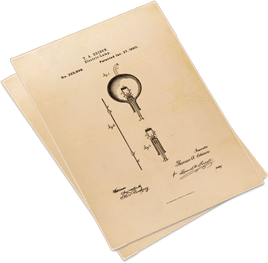The rules regarding when federal registration of trademarks are permitted in the U.S. are straightforward:
No rights exist in a mark until it is in use in commerce; and a mark that is not in use in interstate or international commerce will not be registered.
However, the Trademark Act allows you to file an application to register a mark on an intent-to-use basis before you actually use the mark in commerce. The requirements for filing such an application are only that you have a bona fide intention to use the mark in interstate or international trade, and that you meet all the other lawful requirements for registration. You might file an intent-to-use application, for instance, when:
- you have a product (goods or services) under development that you intend to sell in interstate trade;
- you are selling a product locally (within one state) that you expect to sell in interstate trade, or in non-U.S. markets that you intend to sell in the U.S. as well; or
- you are selling a product in interstate trade under another mark that you intend to sell under the new mark, if it is allowed for registration.
There are certain advantages to filing an application on an intent-to-use basis.
- Typically, it takes about eight months for an unquestioned, unopposed application to proceed to registration. Filing under an intention-to-use the mark, you can get most or all of the processing period behind you before you actually put the mark into public commerce.
- Perhaps more importantly, you can be assured that your mark is registrable before you invest a great deal of time and money into the advertising and promotion of goods and services under that mark.
- The date of filing your application, whether it is a normal application or an intent-to-use application, establishes the priority of your claim to the right to register the mark over others who may later apply to register the same or similar marks.
- Finally, provided you ultimately use the mark in interstate commerce, and a registation of the mark issues, your application’s filing date becomes your “constructive use” date — meaning that the seniority of your rights in your trademark follow from the application’s filing date rather than from the date of actual first use.
An intent-to-use application is processed by the Trademark Office in exactly the same way as a normal application would be processed. It is docketed and publically recorded. It is fully examined. When the examining attorney is satisfied that your mark is entitled to registration, it is published for opposition.
After Allowance
After the opposition period, the processing of an intent-to-use application differs from that of an application alleging prior use of the mark. At that point, where a mark that is already in use in commerce, or that relied on a foreign registration, would be registered, a mark submitted on an intent-to-use basis will be “allowed” for registration. Registration of the mark does not happen until you declare that the mark is in use, along with evidence of the manner of its use. (Note that, if the trademark is used in interstate or international commerce prior to publication of the intent-to-use application, the application may be converted by amendment into an in-use application.
The period of time allowed for filing a declaration of use after allowance is six months, initially. This period may be extended by six-month intervals for up to three years, provided some effort is being made to put the mark into use and fees are paid.
Another way that an intent-to-use application differs from one based on a mark already in use is that the intended mark may not be put into use with all claimed classes of goods and services at the same time. In that case, an intent-to-use application may be divided — and re-divided, if necessary — so that the mark may be registered for use with one or more classes of goods and/or services, while the application for registration in connection with the other goods and services remains pending.


